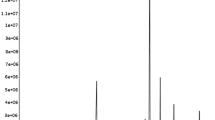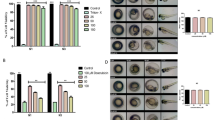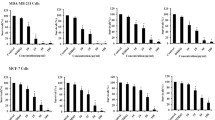Abstract
A multitude of plants have been used extensively for the treatment of cancers throughout the world. The protein, α, β momorcharin has been extracted from the plant Momordica charantia (MC), and it possesses anti-cancer and anti-HIV properties similar to the crude water and methanol soluble extract of the plant. This study investigated the anti-cancer effects and the cellular mechanisms of action of α, β momocharin (200–800 μM) on 1321N1, Gos-3, U87-MG, Sk Mel, Corl-23 and Weri Rb-1 cancer cell lines compared to normal healthy L6 muscle cell line measuring cell viability using MTT assay kit, Caspase-3 and 9 activities, cytochrome c release and intracellular free calcium concentrations [Ca2+]i. The results show that α, β momorcharin can evoke significant dose-dependent (P < 0.05; Student’s t test) decreases in the viability (increases in cell death) of 1321N1, Gos-3, U87-MG, Sk Mel, Corl-23 and Weri Rb-1 cancer cell lines compared to healthy L6 muscle cell line and untreated glioma cells. α, β momorcharin (800 μM) also evoked significant (P < 0.05) increases in caspase-3 and 9 activities and cytochrome c release. Similarly, α, β momorcharin elicited significant (P < 0.05) time-dependent elevation in [Ca2+]i in all five glioma cell lines compared to untreated cells. Together, the results have demonstrated that α, β momorcharin can exert its anti-cancer effect on different cancer cell lines by intracellular processes involving an insult to the mitochondria resulting in cellular calcium over loading, apoptosis, cytochrome release and subsequently, cell death.





Similar content being viewed by others
References
Ahmed I, Sharma AK, Ponery AS, Bener A, Singh J (1999) The influence of Momordica charantia on ultrastructural abnormalities of myelinated fibres in experimental diabetes. Int J Diabetes 7:110–121
Bailey CJ, Day C, Turner SL, Leatherdale BA (1985) Cerasee, a traditional treatment for diabetes. Studies in normal and streptozotocin diabetic mice. Diabetes Res 2:81–84
Singh A, Singh SP, Bamezai R (1998) Momordica charantia (Bitter Gourd) peel, pulp, seed and whole fruit extract inhibits mouse skin papillomagenesis. Toxicol Lett 94:37–46
Welihinda J, Karunanayake EH, Sheriff MH, Jayasinghe KS (1986) Effect of Momordica charantia on the glucose tolerance in maturity onset diabetes. J Ethnopharmacol 17:277–282
Claflin AJ, Vesely DL, Hudson JL, Bagwell CB, Lehotay DC, Lo TM, Fletcher MA, Block NL, Levey GS (1978) Inhibition of growth and guanylate cyclase activity of an undifferentiated prostate adenocarcinoma by an extract of the balsam pear (Momordica charantia abbreviata). Proc Natl Acad Sci 75:989–993
Makin G (2002) Targeting apoptosis in cancer chemotherapy. Expert Opin Ther Targ 6:73–74
Mengen L, Yiwen C, Zhongyu L, Fubing S, Xiaoxiao B, Yanfa M (2009) Anti-tumor activity and immunological modification of ribosome-inactivating protein (RIP) from Momordica charantia by covalent attachment of polyethylene glycol. Acta Biochem 41:790–795
Ng TB, Liu WK, Sze SF, Yeung HW (1994) Action of alpha-momorcharin, a ribosome inactivating protein, on cultured tumor cell lines. Gen Pharmacol 25:75–77
Chang CI, Chen CR, Liao YW, Cheng HL, Chen YC, Chou CH (2008) Cucurbitane-type triterpenoids from the stems of Momordica charantia. Nature 71:1327–1330
Wang HX, Ng TB (2001) Studies on the anti-mitogenic, anti-phage and hypotensive effects of several ribosome-inactivating proteins. Comp Biochem Physiol C 128:359–366
Yuan YR, He YN, Xiong JP, Xia ZX (1999) Three-dimensional structure of beta-momorcharin at 2.55 a resolution. Acta Crystallogr Sect D 55:1144–1151
Brooks KJ, Hargreaves IP, Bates TE (2000) Nitric-oxide-induced inhibition of mitochondrial complexes following aglycaemic hypoxia in neonatal cortical rat brain slices. Neuroscience 22:359–365
Catherine J, Beth S, William F, Esther F (1983) In vivo antitumor activity of the bitter melon (Momordica charantia). Cancer Res 43:5151–5155
Gati I, Bergstrom M, Muhr C, Langstrom B, Carlsson J (1991) Application of (methyl-11C)-methionine in the multicellular spheroid system. J Nucl Med 32:2258–2265
Licastro F, Franceschi C, Barbieri L, Stirpe F (1980) Toicity of Momordica charantia lectin and inhibitor for human normal and leukaemic lymphocytes. Virchows Cell Pathol 33:257–265
CellTiter 96®AQueous (2007) Non-radioactive cell proliferation assay. Promega technical bulletin. www.promega.com/automethods, pp 1–12
CellTiter-Glo®Luminescent cell viability assay. Promega technical bulletin (2009). www.promega.com/automethods, pp 1–14
Luetrakul T (1998) Isolation and characterization of biologically active 30 kDa proteins from the seed of Momordica charantia L. cultivated in Thailand. Pharmacy Thesis, Faculty of Graduate Studies, Mahidol University, Bangkok
Caspase -3 assay method ((2006)) Sigmaaldrich technical bulletin www.Sigmaaldrich.com, pp 1–6
Hajnoczky G, Hager R, Thomas AP (2003) Mitochondria suppress local feedback activation of inositol 1,4, 5-trisphosphate receptors by Ca2+. J Biochem 274:14157–14162
Robinson JM, Dong W-J, Xing J, Cheung HC (2004) Switching of troponin I: Ca2+ and myosin-induced activation of heart muscle. J Mol Biol 340:295–305
Hajnoczky G, Csordas G, Madesh M, Pacher P (2006) The machinery of local Ca2+ signalling between sarco-endoplasmic reticulum and mitochondria. J Physiol 529:69–81
Camello-Almaraz C, Salido GM, Pariente JA, Camello PJ (2002) Role of mitochondria in Ca2+ oscillation and shape of Ca2+ signals in pancreatic acinar cells. J Biochem Pharmacol 63:283–297
Green AK, Cobbold PH, Dixon CJ (1998) Effects on the hepatocyte Ca2+ oscillator of inhibition of the plasma membrane Ca2+ pump by carboxyeosin or glucagon- (19–29). Cell Calcium 22:99–109
Grover JK, Rathi SS, Vats V (2004) Amelioration of experimental diabetic neuropathy and gastropathy in rats following oral administration of plant (Eugenia jambolana, Mucuna pruriens and Tinospora cordifolia) extracts. Indian J Expt Biol 40:273–276
Zhu ZJ, Zhong ZC, Luo ZY, Xiao ZY (1990) Studies on the active constituents of Momordica charantia L. Yaoxue Xuebao 25:898–903
Ganguly C, De S, Das S (2000) Prevention of carcinogen-induced mouse skin papilloma by whole fruit aqueous extract of Momordica charantia. Eur J Cancer Prevent 9:283–288
Fong PC, Haynes LJ, Magnus KE, Plimmer JR (1996) Pharmacological screening of some West Indian medicinal plants. J Pharmacol 14:556–560
Tsao SW, Ng TB, Yeung HW (1990) Toxicities of trichosanthin and alpha-momorcharin, abortifacient proteins from Chinese medicinal plants, on cultured tumour cell lines. Toxicology 28:1183–1192
Heinrich M, Bremner P (2006) Ethnobotany and ethnopharmacy—their role for anti-cancer drug development. Drug Targ 7:39–745
Sun Y, Huang PL, Li JJ, Huang YQ, Zhang L, Huang PL, Lee-Huang S (2001) Anti-HIV agent MAP30 modulates the expression profile of viral and cellular genes for proliferation and apoptosis in AIDS-related lymphoma cells infected with Kaposi’s sarcoma-associated virus. Biochem Biophys Res Commun 287:983–994
Nagasawa H, Watanabe K, Inatomi H (2002) Effects of bitter melon (Momordica charantia) or ginger rhizome (Zingiber offifinale Rosc.) on spontaneous mammary tumorigenesis in SHN mice. J Clin Med 30(2):195–205
Cakici I, Hurmoglu C, Tunctan B, Abacioglu N, Kanzik I, Sener B (1994) Hypoglycaemic effect of Momordica charantia extracts in normoglycaemic or cyproheptadine-induced hyperglycaemic mice. J Ethnopharmacol 44:117–121
Tazzari PL, de Totero D, Bolognesi A, Testoni N, Pileri S, Roncella S, Reato G, Stein H, Gobbi M, Stirpe F (1999) An Epstein–Barr virus-infected lymphoblastoid cell line (D430B) that grows in SCID-mice with the morphologic features of a CD30+ anaplastic large cell lymphoma, and is sensitive to anti-CD30 immunotoxins. Haematologica 84:988–995
Adrain C, Creagh EM, Martin SJ (2002) Caspase cascades in apoptosis. Caspases-their role in cell death and cell survival. Ed. Marek Los and Henning Walczak. Mol Biol Intell 24:41–51
Acknowledgements
Both Chandrasekar Manoharan and Seema Jaiswal were doctoral students in the School of Pharmacy and Biomedical Sciences at UCLAN. We are also grateful to Dr. Julie Shorrocks and Dr. Anthony Ashton for technical assistance including tissue culture and calcium measurement, respectively.
Author information
Authors and Affiliations
Corresponding author
Rights and permissions
About this article
Cite this article
Manoharan, G., Jaiswal, S.R. & Singh, J. Effect of α, β momorcharin on viability, caspase activity, cytochrome c release and on cytosolic calcium levels in different cancer cell lines. Mol Cell Biochem 388, 233–240 (2014). https://doi.org/10.1007/s11010-013-1914-1
Received:
Accepted:
Published:
Issue Date:
DOI: https://doi.org/10.1007/s11010-013-1914-1




